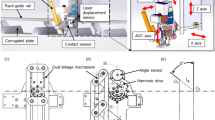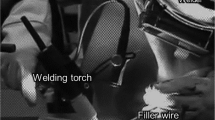Abstract
While automated welding tends to be the mainstream in modern joining, manual welding still plays an irreplaceable role. Human welder’s experience and skills are critical for many applications where decisions need to be made based on interactions with the process. Understanding the mechanism of human welder intelligence may establish the foundation to develop new methods to better train welders and develop intelligent welding robots that combine intelligence with high physical strength and motion accuracy. As the first effort to study the welders’ behavior mechanism, this paper focuses on answering two fundamental questions: (1) What information that the welders acquire through their observation of the weld pool? 2) how human welders intelligently respond, i.e., adjust welding parameter(s), to the sensory information they obtain? In particular, the principle of welders’ behavior is analyzed from modeling’s point of view. To answer the first question, the weld pool surface is characterized to find the information which is able to indicate the weld quality/penetration. It is found that the length, width, and convexity of weld pool surface provide an optimal estimation of the weld penetration. They can be considered the characteristic parameters/information welders acquire. For the second question, the mechanism of a welder’s behavior/adjustment on welding current as a response to the characteristic parameters is mathematically formulated. The dynamic models of the welder’s behavior are obtained and analyzed. To demonstrate one of the applications of the obtained model, i.e., transferring the welder’s wisdom into automated welding, the dynamic model is implemented as a controller into the automated gas tungsten arc welding (GTAW). Experiments have been designed and conducted with different welding conditions (arc length, i.e., the length of arc by a conversion of the measured arc voltage and joint gap) and initial currents. It has been found that the model is capable of adjusting the current intelligently such that a consistent full penetration is achieved despite the variations in those conditions/parameters.























Similar content being viewed by others
References
O’Brien R (ed) (1998) Welding Handbook, 8th edn, vol 2. Welding Processes. AWS
Uttrachi GD (2007) Welder shortage requires new thinking. Weld J 86(1):6
(2007) Welding shortage fact sheet. American Welding Society. [Online]. Available: http://files.aws.org/pr/shortagefactsheet.pdf
Shuster S (2011) Fire at fourth reactor: is worse yet to come in the fukushima nuclear disaster? TIME. [Online]. Available: http://www.time.com/time/world/article/0,8599,2059232,00.html
Kotecki DJ, Cheever D, Howden D (1972) Mechanism of ripple formation during weld solidification. Weld J 51(8):386s–391s
Renwick R, Richardson R (1983) Experimental investigation of gta weld pool oscillations. Weld J 62(2):29s–35s
Zacksenhouse M, Hardt D (1984) Weld pool impedance identification for size measurement and control. ASME J Dyn Syst Meas Control 105(3):179–184
Graham G, Ume I (1997) Automated system for laser ultrasonic sensing of weld penetration. Mechatronics 7(8):711–721
Hopko S, Ume I (1999) Laser generated ultrasound by material ablation using fiber optic delivery. Ultrasonics 37(1):1–7
Chen W, Chin B (1990) Monitoring joint penetration using infrared sensing techniques. Weld J 69(4):181s–185s
Nagarajan S, Banerjee P, Chen W, Chin B (1992) Control of the welding process using infrared sensors. IEEE Trans Robot Autom 8(1):86–93
Banerjee P et al (1995) Infrared sensing for online weld shape monitoring and control. ASME J Eng Ind 117:323–330
Wikle HC, Zee RH, Chin B (1999) Sensing system for weld process control. J Mater Process Technol 89–90:254–259
Lin M, Eagar T (1985) Influence of arc pressure on weld pool geometry. Weld J 64(6):163–169
Rokhlin S, Guu A (1993) A study of arc force, pool depression, and weld penetration during gas tungsten arc welding. Weld J 72(8):381–390
Zhang YM, Li L, Kovacevic R (1995) Monitoring of weld pool appearance for penetration control. In proceedings of the 4th international conference. pp 683–688
Kovacevic R, Zhang YM (1996) Sensing free surface of arc weld pool using specular reflection: Principle and analysis. Proc IME B J Eng Manufact 210(6):553–564
Kovacevic R, Zhang Y (1996) Monitoring of weld joint penetration based on weld pool geometrical appearance. Weld J 75(10):317-329
Zheng B, Wang HJ, Wang QI, Kovacevic R (2000) Control for weld penetration in vppaw of luminum alloys using the front weld pool image signal. Weld J:363s–370s
Balfour C, Smith J, Al-Shamma A (2006) A novel edge feature correlation algorithm for real-time computer vision-based molten weld pool measurements. Weld J 85(1):1s–8s
Zhang WJ, Liu Y, Zhang YM (2012) Characterization of three-dimensional weld pool surface in gtaw. Weld J 91(7):195s–203s
Gaines B (1969) Linear and nonlinear models of the human controller. Int J Man-Machine Stud:1333–360
McRuer D, Graham D, Krendel E, Reisener W (1965) Human pilot dynamics in compensatory systems, air force flight dynamics laboratory, Wright-Patterson AFB. Ohio. Technical Report
Kleiman DL, Baron S, Levison WH (1970) An optimal model of human response, part 1. theory and validation. Automatica 6:357–369
Chen LK, Ulsoy AG (2000) Identification of a nonlinear driver model via narmax modeling. In proceedings of American control conference. pp 2533–2537
Tsuji T, Tanaka Y (2005) Tracking control properties of human-robotic systems based on impedance control. IEEE Trans Syst Man Cybern Part A: Syst Hum 35(4):523–535
Itoh E, Suzuki S (2005) Nonlinear approach for human internal models: Feed forward and feedback roles in pilot maneuver. In 2005 IEEE international conference of systems man and cybernetics, vol 3. pp 2455–2462
Delice II, Ertugrul S (2007) Intelligent modeling of human driver: a survey. In 2007 IEEE intelligent vehicles symposium. pp 648–651
Ertugrul S (2008) Predictive modeling of human operators using parametric and neuro-fuzzy models by means of computer-based identification experiment. Eng Appl Artif Intell 21:259–268
Zhang WJ, Zhang YM (2012) Modeling of human welder response to 3d weld pool surface: Part i- principles. Weld J 91(11):310s–318s
Zhang WJ, Zhang YM (2012) Modeling of human welder response to 3d weld pool surface: Part ii-results and analysis. Weld J (accepted for publication) 91(12):329s–337s
Zhang W J, Zhang Y M (2012) Dynamic control of gtaw process using human welder response model. Weld J (accepted for publication)
Song H S, Zhang Y M (2007) Image processing for measurement of three-dimensional gta weld pool surface. Weld J 86(10):323s–330s
Saeed G, Zhang Y M (2003) Mathematical formulation and simulation of specular reflection based measurement system for gas tungsten arc weld pool surface. Meas Sci Technol 14(8):1671–1682
Zhang W J, Zhang Y M (2012) Automated three-dimensional reconstruction of weld pool surface in gtaw process. IEEE Trans Autom Sci Eng Rev
Zhang Y M, Li L (1997) Dynamic estimation of full penetration using geometry of adjacent weld pools. J Manuf Sci Eng 19:631–644
Astrom K J, Wittenmark B (1995) Adaptive control. Addison-Wesley
Richard G L (2007) Statistical concepts: a second course, 3rd edn. Routledge Academic
DuPont J N, Marder A R (1995) Thermal efficiency of arc welding processes. Weld J 74(12):406s–416s
Tay T, Mareels I, Moore JB (1997) High performance control. Birkhuser
Acknowledgments
This work is funded by the National Science Foundation under grant CMMI-0927707 entitled “Machine-Human Cooperative Control of Welding Process” and CMMI- 1208420 entitled “NRI-Small: Virtualized Welding: A New Paradigm for Intelligent Welding Robots in Unstructured Environment”. We wish to thank Mr. Yi Lu and Mr. Yukang Liu for their assistance on experiments and graphics, and Mr. Lee Kvidahl for his technical guidance on manual pipe welding.
Author information
Authors and Affiliations
Corresponding author
Additional information
Doc. IIW-2452, recommended for publication by Commission VIII “Health, Safety and Environment.”
This research work was supervised by Dr. YuMing Zhang at the University of Kentucky, USA
Rights and permissions
About this article
Cite this article
Zhang, W. Modeling of human welder behavior in gas tungsten arc welding of stainless steel tubes. Weld World 58, 601–617 (2014). https://doi.org/10.1007/s40194-014-0137-8
Received:
Accepted:
Published:
Issue Date:
DOI: https://doi.org/10.1007/s40194-014-0137-8




